大学英语精读(1)unit 1(第三讲)
- 格式:ppt
- 大小:1.52 MB
- 文档页数:42
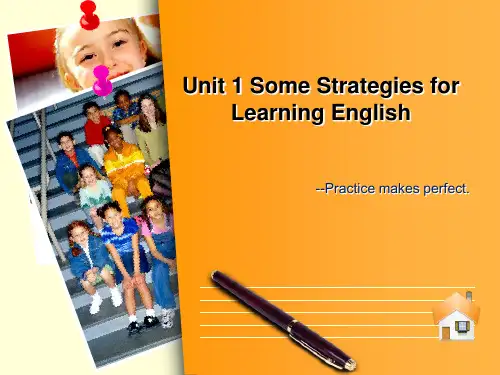
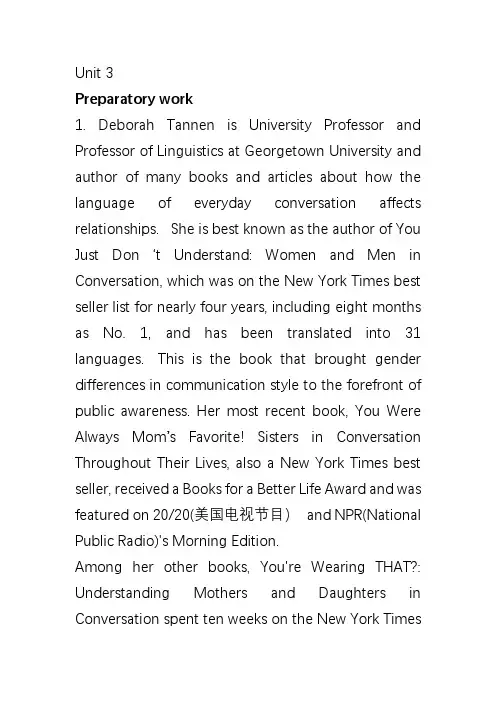
Unit 3Preparatory work1. Deborah Tannen is University Professor and Professor of Linguistics at Georgetown University and author of many books and articles about how the language of everyday conversation affects relationships. She is best known as the author of You Just Don ‘t Un derstand: Women and Men in Conversation, which was on the New York Times best seller list for nearly four years, including eight months as No. 1, and has been translated into 31 languages. This is the book that brought gender differences in communication style to the forefront of public awareness. Her most recent book, You Were Always Mom’s Favorite! Sisters in Conversation Throughout Their Lives, also a New York Times best seller, received a Books for a Better Life Award and was featured on 20/20(美国电视节目)and NPR(National Public Radio)'s Morning Edition.Among her other books, You're Wearing THAT?: Understanding Mothers and Daughters in Conversation spent ten weeks on the New York Timesbest seller list; Talking from 9 to 5: Women and Men at Work was a New York Times Business best seller; The Argument Culture: Stopping America's War of Words received the Common Ground Book Award; and I Only Say This Because I Love You: Talking to Your Parents, Partner, Sibs, and Kids When You're All Adults received a Books for a Better Life Award.In addition to her seven books for general audiences, Tannen is author or editor of sixteen books and over one hundred articles for scholarly audiences. She has also published poems, short stories, plays and personal essays.Academic interests: gender and language, interactional sociolinguistics, conversational interaction, cross-cultural communication, frames theory, conversational vs. literary discourse, and new media discourse.Main publications:You Just Don't Understand: Women and Men in Conversation. New York: Morrow, 1990.That's Not What I Meant!: How Conversational Style Makes or Breaks Relationships. NY: William Morrow,1986.Gender and Discourse. NY & Oxford: Oxford University Press, 1994.2)Edward SapirEdward Sapir (/səˈpɪər/; 1884–1939) was an American anthropologist-linguist, who is widely considered to be one of the most important figures in the early development of the discipline of linguistics. Sapir studied the ways in which language and culture influence each other, and he was interested in the relation between linguistic differences, and differences in cultural world views. This part of his thinking was developed by his student Benjamin Lee Whorf into the principle of linguistic relativity or the "Sapir-Whorf" hypothesis.2) John Joseph GumperzJohn Joseph Gumperz (January 9, 1922 –March 29, 2013) was an American linguist and academic. Gumperz was, for most of his career, a professor at the University of California in Berkeley. His research on the languages of India, on code-switching in Norway, and on conversational interaction, has benefitted the studyof sociolinguistics, discourse analysis, linguistic anthropology, and urban anthropology.2) E. M. ForsterE.M. Forster, in full Edward Morgan Forster (born January 1, 1879, London, England—died June 7, 1970, Coventry, Warwickshire), British novelist, essayist, and social and literary critic. His fame rests largely on his novels Howards End (霍华德庄园)(1910) and A Passage to India (印度之旅)(1924) and on a large body of criticism. He is known best for his ironic and well-plotted novels examining class difference and hypocrisy in early 20th-century British society. He was nominated for the Nobel Prize in Literature in 13 different years.2) Robert KaplanAmerican applied linguist. His research area covers applied linguistics, discourse analysis, language policy, language planning, and ESL/EFL Teaching. He is most famous for his contribution in Contrastive Rhetoric(对比修辞), a term he first coined in 1966. Kaplan has authored or edited 32 books, more than 130 articles in scholarly journals and chapters in books, and morethan 85 book reviews and other ephemeral(short-lived) pieces in various newsletters(时事通讯), as well as 9 special reports to the U.S. government and to governments elsewhere.3) pragmaticsPragmatics is a systematic way of explaining language use in context. It seeks to explain aspects of meaning which cannot be found in the plain sense of words or structures, as explained by semantics. As a field of language study, pragmatics is fairly new. Its origins lie in philosophy of language and the American philosophical school of pragmatism. As a discipline within language science, its roots lie in the work of (Herbert) Paul Grice on conversational implicature(会话含义)and the cooperative principle(合作原则), J. L. Austin and John Searle on speech act(言语行为), and on the work of Stephen Levinson, Penelope Brown and Geoff Leech on politeness.4) Cohesion refers to the use of various phonological, grammatical, and/or lexical means to link sentences or utterances into a well-connected, larger linguistic unit such as a paragraph or a chapter. In other words,cohesion achieves well-connectedness by means of linguistic forms.Example: Mary is a secretary. She works in a law firm.5) Pause is a temporary and brief break in the flow of speech, which is often classified into filled pause(有声停顿)and unfilled or silent pause(无声停顿). The former is taken up or filled by a hesitation form like ah, er, and um. In contrast, the latter is not filled by a hesitation form. In other words, a silent pause is one where there is no vocalization(发声).Critical readingI. Comprehension CheckI. Understanding the text(1) The main purpose of this article is to illustrate eight levels of cross-cultural differences in non-verbal aspects of communication.(2) We can understand the nature of language by observing it in communication and in contact with other systems of communication.(3) Pacing and pausing, listenership. In deciding when to talk and what to say, the speaker usually takes a conscious speech planning, yet in pacing and pausingand in showing listenership in a conversation, one does not need to stop and think for a decision. Section 2.1 starts with a direct thesis statement. Then the author explains it with an expert’s (Scollon) research findings and examples.In section 2.2 the author raises a number of questions (in paras 7, 9 and 11) and responds to them with relevant research findings (Goody’s as well as hers) and her own personal experience.Section 2.3 is also organized in the order of “question-answer”.Section 2.4 illustrates cross-cultural differences in listenership with two examples, gaze (paras 21 and 22) and loud responses (para 23), and then moves on to the conclusion (para 24).Section 2.5: example-discussion.Section 2.6: personal experience and a very brief interpretation.Section 2.7: the thesis (para 30 “how to be indirect is culturally relative”) and discussion about the cases of American-non-American differences (American men, women, Greek and Japanese).Section 2.8: definition and illustration.(5) The experience in a dinner party in paragraph 12 indicates that (1) people from different cultures not only differ in whether compliments should be accepted, rejected or deflected, but also in which compliments should be accepted/rejected/deflected; and (2) every culture has its own conventions about what to say on particular occasions, and without knowledge of these conventions, we can by no means appropriately interpret the messages in cross-cultural communication.In Para. 29, Tannenrefers to her first visit to Greece to exemplify the cross-cultural difference in formulaicity, i.e., what is novel and what is conventional in different languages.(6) Generally speaking, the eight levels are arranged in the order of importance, from the core of verbal communication to more peripheral (secondary) factors. The first three levels and the fifth level belong to what is said while the last three center on how it is said. The fourth level, listenership, is the only level examined from the perspective of the hearer.(7) As has been illustrated in part II, verbal communication involves many hidden rules and conventions that vary from culture to culture. Since every individual has his/her own unique experience, education background,and beliefs, etc., no two interactants would share exactly the same communicative rules and conventions. In this sense all communication is cross-cultural.II. Evaluation and exploration1.Evaluating the text(1)Personal experiences and anecdotes help elucidate (阐明)abstract and difficult terms and add to the vividness of the text. Controlled use of personal experience may also shorten the distance between the author and the reader. But the overuse and misuse of personal stories can also damage the objectivity and credibility of the argumentation.(2). Falter: to become weaker and unable to continue in an effective way (Longman)(3)Which levels of communication difference are labeled automatic processing in the text? Why? Pacing and pausing, listenership. In deciding when totalk and what to say, the speaker usually takes a conscious speech planning(section 2.1&2.2), yet in pacing and pausing and in showing listenership in a conversation, one does not need to stop and think for a decision(para. 20).Why pacing and pausing is automatic because we have got accustomed to it in our daily life and made it a truism or formula after practicing it again and again in our daily communication. We have remembered the subtle change of pacing and pausing(para 19)(2)Beside personal experience, Tannen mentions a lot of academic researches (e.g. in para 4, 7, 8, 10, 21, 23, 38 and 39), which all add weight to her arguments.(3)It is obviously not an exhaustive list. Cross-cultural communication can vary at many other levels, e.g., proxemics(人际距离学/亲近学) and turn-taking(话语轮次)in a multiparty context.2.Exploring beyond the text(1)Questions for exploration1)There are altogether 16 questions which help structure the text in part two and they are not equally important. The question in para 2, for example, is a global one that covers all the eight sections in the main body, while the question in para 20, “Now how many milliseconds shall I wait?”, is just an example to illustrate why pacing and pausing is an automatic level.a. See above.b. The first question in para 7 is asked to introduce the topic of this section, what to say. It is a transition from section 2.1 to section 2.2.c. This is a rhetorical question requiring no answer. It is asked simply to reinforce our conviction that questions are basic to the educational setting, which forms a sharp contrast with the case of Gonjans.2) In all the known languages there are strategies of making indirect requests/apologies/invitations/, etc. In a strict sense, the use of language is an indirect means to achieve communicative ends. How to be indirect differs from culture to culture. For example, in English a request is often put forward as a question of ability(Can you pass me the salt?).3) For example, introvert(内向的)people may be more tolerant of silence in face-to-face verbal interaction while extroverts(外向的)usually find silence awkward and uncomfortable. This is primarily an interpersonal difference since in all cultures there are introvert and extrovert people.Gaze is another example. People with more aggressive personality usually hold longer and steadier gaze when they talk to others, while shy people more likely to diverge in eye contact.Language enhancementI. Words and phrases1. Adverbs and prepositions(1) off (2) out (3) across (4) away (5) up (6) between, for (7) after (8) out of, into (9) off (10) up (11) out of2. Verbs(1) illustrate, vary, discussing, exemplifying, signaling, mean, say(2) vary(3) differ(4) illustrated(5) exemplifies(6) expounds(7) demonstrates(8) elucidate, interpretII. Sentences and discourse1.Paraphrasing(1)Athabaskan Indians consider that it is inappropriate to talk to people they do not know. According to Scollon, this causes a strange effect when theAthabaskan Indians meet people from other cultures. The non-Athabaskans may want to make acquaintance with the Athabaskans by talking to them, but the Athabaskans will not talk to the non- Athabaskans before they become acquaintances. (2)Gonjans take it for granted that questions are always asked to achieve indirect functions, so they never ask questions for pure information.(3)The Americans usually take it for granted that in communication people should be direct and say no more or less than needed, and that what people say is exactly what they mean. This is especially true inbusiness and education and applies more to American men than to women.(4)No two people have just the same cultural background. Therefore, all communication is cross-cultural to someextent. In this sense, understanding cross-cultural communication can help us understand the nature of language and tackle problems in the world, especially those caused by and related to the use of language, e.g. obstacles in foreign language teaching and learning.2.Translation(1)物理学家通过观察物质元素在不同环境中的表现及其与其他物质的相互作用来理解它们的本质。
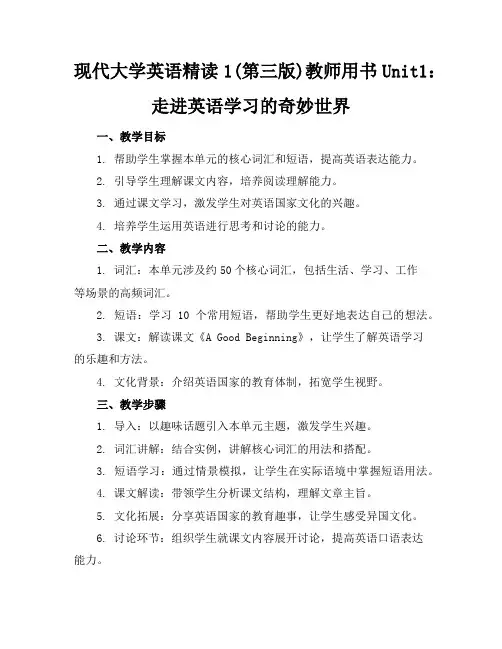
现代大学英语精读1(第三版)教师用书Unit1:走进英语学习的奇妙世界一、教学目标1. 帮助学生掌握本单元的核心词汇和短语,提高英语表达能力。
2. 引导学生理解课文内容,培养阅读理解能力。
3. 通过课文学习,激发学生对英语国家文化的兴趣。
4. 培养学生运用英语进行思考和讨论的能力。
二、教学内容1. 词汇:本单元涉及约50个核心词汇,包括生活、学习、工作等场景的高频词汇。
2. 短语:学习10个常用短语,帮助学生更好地表达自己的想法。
3. 课文:解读课文《A Good Beginning》,让学生了解英语学习的乐趣和方法。
4. 文化背景:介绍英语国家的教育体制,拓宽学生视野。
三、教学步骤1. 导入:以趣味话题引入本单元主题,激发学生兴趣。
2. 词汇讲解:结合实例,讲解核心词汇的用法和搭配。
3. 短语学习:通过情景模拟,让学生在实际语境中掌握短语用法。
4. 课文解读:带领学生分析课文结构,理解文章主旨。
5. 文化拓展:分享英语国家的教育趣事,让学生感受异国文化。
6. 讨论环节:组织学生就课文内容展开讨论,提高英语口语表达能力。
7. 作业布置:巩固所学知识,为下一节课做好准备。
四、教学建议1. 针对不同水平的学生,适当调整教学难度和进度。
2. 创设生动、有趣的教学情境,提高学生的学习积极性。
3. 注重培养学生的自主学习能力,鼓励学生课外阅读英语文章。
4. 定期进行课堂互动,关注学生的发音、语法等细节问题。
5. 结合实际生活,让学生在实践中感受英语的魅力。
五、教学方法1. 互动式教学:采用提问、小组讨论等形式,让学生在互动中学习,提高课堂参与度。
2. 情境模拟:通过角色扮演、情景对话等方式,让学生在真实语境中运用所学知识。
3. 任务驱动:设计一系列学习任务,引导学生主动探索、解决问题,培养解决问题的能力。
4. 多媒体辅助:利用音频、视频等资源,丰富教学手段,提高学生的学习兴趣。
六、课堂活动设计1. 词汇接龙:让学生轮流用本单元学到的词汇进行接龙,巩固记忆。
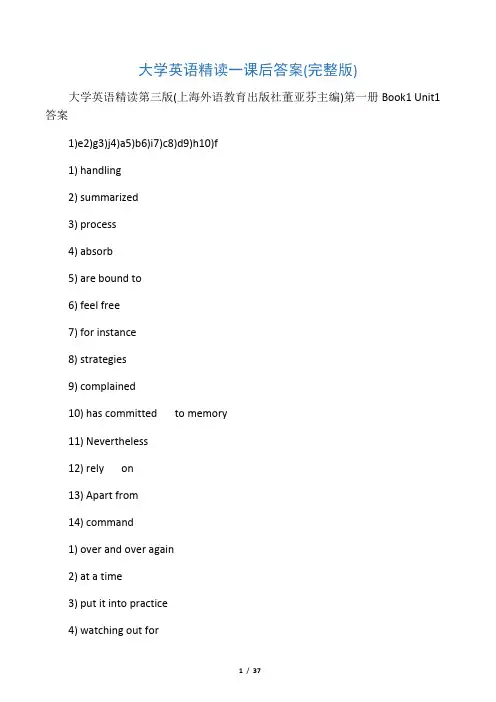
大学英语精读一课后答案(完整版)大学英语精读第三版(上海外语教育出版社董亚芬主编)第一册Book1 Unit1答案1)e2)g3)j4)a5)b6)i7)c8)d9)h10)f1) handling2) summarized3) process4) absorb5) are bound to6) feel free7) for instance8) strategies9) complained10) has committed to memory11) Nevertheless12) rely on13) Apart from14) command1) over and over again2) at a time3) put it into practice4) watching out for5) by no means6) concentrate on7) In addition t8) in detail1)action2)employ3)announce4)examination5)communication6)express7)compose8)improvement9)concentration10)management11)consider12)motivate13)development14)movement15)discuss16)operate17)division18)production19)educate20)repeat1) additional2) add3) addition4) addition1) effectively2) effect3) effective4) effect1) helpful2) help3) helpless4) help5) helplessly6) helpfully7) helpful1) reliant2) reliable3) reliance reliable4) relies5) reliably6)1) repetition2) repeating3) repeatedly4) repeated5) repetition1) In my opinion2) According to Mary3) In our opinion4) According to today's papers5) In most doctors' opinion According to most doctors1) Shakespeare was not only a dramatist but also an actor.2) Miss Crain not only took me home in her car, but also camethe next day to see if I hadrecovered.3)Hainan Island attracts tourists not only in winter but also in summer.4)There is always a black market not only in Britain,but also in other European countries.5)At the Athens Olympics in 2004,Liu Xiang not only won a gold medal in the 110-meter hurdles,but also broke the Olympic record.1)It is true that your sentences are all grammatically correct,but they don’t make any sense.2) It is true that they lost that battle, but they still wenton fighting.3) It is true that Tom’s very clever and hardworking, but Istill don’t think he is the right person forthe job.4) It is true that learning English is by no means easy, butwe can make the task easier by usingsome learning strategies.1) strategies2) frequently3) over and over again4) commit to memory5) acquaintance6) watch out for7) communicate8) process9) opportunities10) rely on11) put into practice12) absorbed1) if2) about3) it4) know5) up6) as7) addition8) even9) into10) other11) for12) while1) memorize2) a matter of3) taught4) shelf5) realize6) written7) idiomatic8) join in9) difference10) gain a good command 翻译1)史密斯太太对我抱怨说,她经常发现与自己十六岁的女儿简直无法沟通。

Unit11。
他们利用我们求助无门的困境把我们公司接管了。
They took advantage of our helpless situation and took over our company.2. 虽然我们面前仍有困难,但我肯定我们中国人有智慧靠自己实现国家的和平统一。
Although there are still difficulties ahead of us, I am sure that we Chinese people will have the wisdom to bring about the peaceful unification of our country on our own3. 只强调国内生产总值是错误的,它会引起很多严重问题。
It is wrong to put emphasis on nothing but GDP. It will give rise to many serious problems.4. 他喜欢炫耀他的财富,但是这完全是徒劳的,人们仍然像躲避毒药那样躲避他。
He loves to show off his wealth, but that is all in vain。
People still avoid him as though he were poison。
5. 他不久就爱上了这个村子。
他决心和村民一起把这个地方变成一个花园。
He soon fell in love with the village and was determined to make it a beautiful garden together with other villagers.6。
我们必须花更多的钱来和全球气温上升作斗争。
另外,我认为我们还必须采用严厉的法律措施.这不只是一个钱的问题。
We must spend more money fighting against global warming. In addition, we must resort to tough laws. It is not just a matter of money。


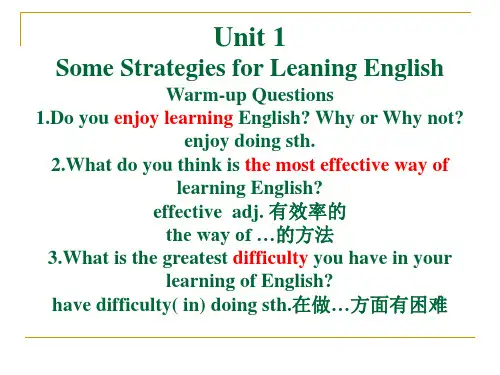
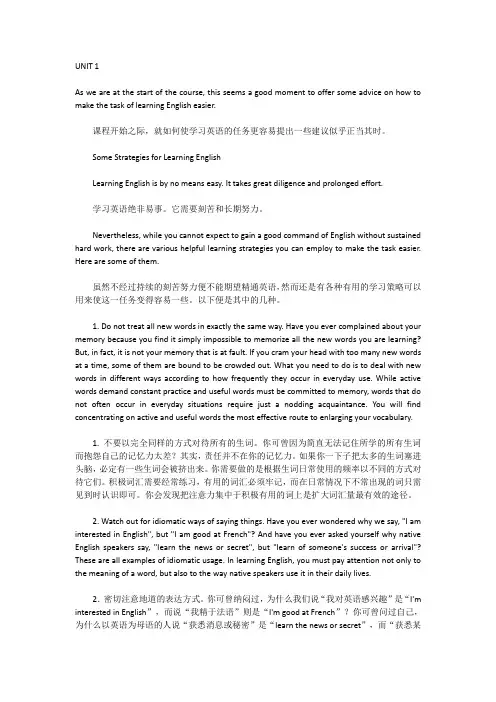
UNIT 1As we are at the start of the course, this seems a good moment to offer some advice on how to make the task of learning English easier.课程开始之际,就如何使学习英语的任务更容易提出一些建议似乎正当其时。
Some Strategies for Learning EnglishLearning English is by no means easy. It takes great diligence and prolonged effort.学习英语绝非易事。
它需要刻苦和长期努力。
Nevertheless, while you cannot expect to gain a good command of English without sustained hard work, there are various helpful learning strategies you can employ to make the task easier. Here are some of them.虽然不经过持续的刻苦努力便不能期望精通英语,然而还是有各种有用的学习策略可以用来使这一任务变得容易一些。
以下便是其中的几种。
1. Do not treat all new words in exactly the same way. Have you ever complained about your memory because you find it simply impossible to memorize all the new words you are learning? But, in fact, it is not your memory that is at fault. If you cram your head with too many new words at a time, some of them are bound to be crowded out. What you need to do is to deal with new words in different ways according to how frequently they occur in everyday use. While active words demand constant practice and useful words must be committed to memory, words that do not often occur in everyday situations require just a nodding acquaintance. You will find concentrating on active and useful words the most effective route to enlarging your vocabulary.1. 不要以完全同样的方式对待所有的生词。

现代大学英语精读1(第三版)教师用书Unit1 Unit 1: Greetings and Introductions在当今这个全球化的世界里,掌握一门外语显得尤为重要。
英语作为一门国际通用语言,已经成为许多人学习和交流的首选。
为了帮助学生们更好地掌握英语,我们特别编写了这本《现代大学英语精读1(第三版)教师用书》。
这本书分为多个单元,每个单元都围绕一个特定的主题展开,旨在帮助学生提高英语听、说、读、写四方面的能力。
本单元的主题是“问候与介绍”。
这是我们在与人交往中最常用的场景之一。
通过本单元的学习,学生们将学会如何用英语进行自我介绍,如何问候他人,以及如何进行简单的对话。
这将有助于他们在日常生活中更加自信地使用英语。
2. 介绍:学生们将学习如何用英语介绍自己,包括姓名、年龄、职业、兴趣爱好等。
他们还将学习如何介绍他人,以及如何回应他人的介绍。
3. 对话:学生们将通过实际对话练习,提高自己的英语口语表达能力。
他们将学会如何就天气、日常生活等话题进行简单交流。
4. 阅读理解:本单元还安排了一篇关于问候与介绍的阅读材料,学生们将通过阅读,进一步了解不同文化背景下的问候方式。
5. 写作练习:为了提高学生的写作能力,本单元还设计了一些写作练习,如写一封自我介绍的信、写一篇关于问候与介绍的短文等。
通过本单元的学习,学生们将能够熟练地运用英语进行问候与介绍,为今后的英语学习打下坚实基础。
同时,这也将有助于他们在实际生活中更好地与人沟通,拓宽自己的交际圈子。
现代大学英语精读1(第三版)教师用书Unit1Unit 1: Greetings and Introductions在本单元的学习中,我们将探讨如何以自然、流畅的方式用英语进行问候与介绍。
通过一系列精心设计的活动和练习,学生们将逐步提高他们的英语交际能力。
我们将关注如何在不同场合下恰当地使用问候语。
例如,在正式场合,如商务会议或学术交流中,使用“Goodmorning/afternoon/evening”会更加得体;而在朋友聚会或休闲场合,简单的“Hi”或“Hello”就足够了。
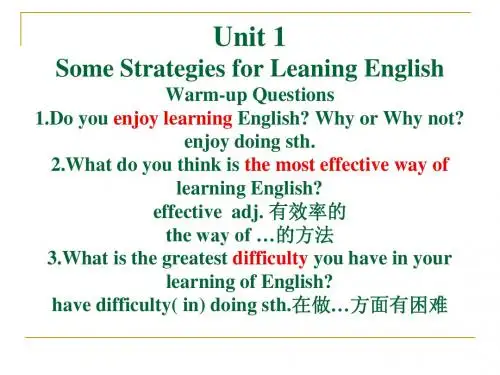
大学英语精读第三版(上海外语教育出版社董亚芬主编)第一册答案Book 1 Unit 1Study&Practice V ocabulary Activities1.1)e 2)g 3)j 4)a 5)b 6)i 7)c 8)d 9)h 10)f2.1) handling2) summarized3) process4) absorb5) are bound to6) feel free7) for instance8) strategies9) complained10) has committed... to memory11) Nevertheless12) rely... on13) Apart from14) command3.1) over and over again2) at a time3) put it into practice4) watching out for5) by no means6) concentrate on7) In addition to8) in detailEnriching Y our Word Power1.1)action2)employ3)announce4)examination5)communication6)express7)compose8)improvement9)concentration10)management11)consider12)motivate13)development14)movement15)discuss16)operate17)division18)production19)educate20)repeat2.1) a) additional b) add c) addition d) addition2) a) effectively b) effect c) effective d) effect3) a)helpful b) help c) helpless d) help e) helplessly f) helpfully g) helpful4) a) reliant b) reliable c) reliance, reliable d) relies e) reliably5) a) repetition b) repeating c) repeatedly d) repeated e) repetitionUsage1) In my opinion2) According to Mary3) In our opinion4) According to today’s papers5) In most doctors’ opinion ( According to most doctors)Structure1.1) Shakespeare was not only a dramatist but also an actor.2) Miss Crain not only took me home in her car, but also came the next day to see if I had recovered.3) Hainan Island attracts tourists not only in winter but also in summer.4) There is always a black market not only in Britain, but also in other European countries.5) At the Athens Olympics in 2004, Liu Xiang not only won a gold medal in the 110-meter hurdles, but also broke the Olympic record.2.1) It is true that your sentences are all gr ammatically correct, but they don’t make any sense.2) It is true that they lost that battle, but they still went on fighting.3) It is true that Tom’s very clever and hardworking, but I still don’t think he is the right person for the job.4) It is true that learning English is by no means easy, but we can make the task easier by using some learning strategies.Cloze1.1) strategies2) frequently3) over and over again4) commit to memory5) acquaintance6) watch out for7) communicate8) process9) opportunities10) rely on11) put into practice12) absorbed2.1) if2) about3) it4) know5) up6) as7) addition8) even9) into10) other11) for12) whileSpot Dictation1) memorize2) a matter of3) taught4) shelf5) realize6) written7) idiomatic8) join in9) difference10) gain a good commandTranslation1) 史密斯太太对我抱怨说,她经常发现与自己十六岁的女儿简直无法沟通。
第三单元Translation of Text A土地的讯息皮拉·萨哈姆1 是的,这些事我们家的稻田,以前归我父母,再往前属于我的祖先。
这片土地已有三百多年的历史了。
我是家里唯一的闺女,我一直留在我父母身边,知道他们去世。
按照我们伊萨的习俗,我的三个兄弟已结婚就都搬到他们老婆家去了,我老伴进了我家的门。
那是我十八岁,他十九岁。
我们俩生了六个孩子,两个没长大就病死了。
其余的俩儿子、俩闺女一到我们有钱给他们买牛仔裤的时候就都离开了家。
大儿子在曼谷找了份工作,给一家有钱人当花匠,后来一家劳务公司介绍他都国外去干活了,小儿子也去了挺远的地方。
2 我们的一个闺女在曼谷一家纺织厂里干活,另外一个闺女在一家商店里工作。
有时候她们会回来看我们,呆上几天就走,她们不时寄些钱回来,捎话回来说她们挺好的。
我知道她们说的不全是实话,有时候,她们受欺负、受侮辱,想到这些,我就觉得像一把尖刀扎进我的心头。
对我老伴来说还好受些,他有耳朵么也听不见,有嘴么也不说,有眼睛么也看不见。
他老是什么事都不着急,什么话也不说,只操心他自己的那点事。
3 虽说这些孩子长期不在我身边,但他们永远都是我的孩子,他们一个个都走了,这可能就是命吧。
我们的那块地不大,连年的使用已使它不再肥沃,就像我们老两口儿,慢慢老下去,且疲惫不堪。
不过我和老伴还在这块地力里干活儿,雨量充足的时候,地还不难耕种,老天爷不下雨的年份,不光是我们的犁断了,我们的心也碎了。
4 没,我们俩没怎么变,可我们的村子变了哪些地方变了?就在十年以前,我们还能以物换物,可如今都用钱了。
几年前,我们还能请街坊来帮忙盖房子、收割稻子或是打井。
这会儿,都得付钱,他们才肯帮忙。
塑料玩意替代了村里手工做的东西,以前男人们还做点竹器,可如今没人干了。
现在村里到处都是乱扔的塑料袋,一下子冒出来不少商店,里面放满了五颜六色的塑料玩意,还有些我们用不上的东西。
年轻人都去镇上和城里打工,留下我们这些老年人种地。
Unit 1一、词汇短语Textstrategy [] n. 战略,策略;计划;对策,政策【例句】By careful strategy she negotiated a substantial pay rise. 她精心策划后,协商了大幅度增加工资的事。
【派生】strategic adj.战略上的,战略的means [] n. 手段,方法|| v. 意味,想要【例句】Have you the means to support a wife? 你有钱供养妻子吗?【词组】by means of 用,依靠by no means 绝不nevertheless [] conj. (nonetheless)然而,不过|| adv. 然而;虽然如此;依然【例句】She was very tired, nevertheless, she kept on working. 她虽然很疲倦,可仍在继续工作。
command [] n. 命令,支配,指挥|| v. 命令,指挥,掌握;博得【例句】The general commanded his men to attack the city. 将军下令部下攻城。
【派生】commanding adj.指挥的;居高临下的;威风凛凛的|| commander n.指挥官;司令官sustain [] vt. 支撑,撑住;维持,持续;经受;忍耐【例句】The court sustained his claim that the contract was illegal.法庭确认他的要求正当,宣布该合同不合法。
【词组】sustain a family 维持家计【助记】sus(从下边)+tain(维持)→从下边维持→支撑【派生】sustainable adj.可以忍受的;足可支撑的;养得起的|| sustainability n.持续性;永续性;能维持性helpful [] adj. 有帮助的,有益的,有用的【例句】The helpful boy carried my bags for me. 这个好心的男孩帮我搬运提包。
Unit 3Preparatory work1. Deborah Tannen is University Professor and Professor of Linguistics at Georgetown University and author of many books and articles about how the language of everyday conversation affects relationships. She is best known as the author of You Just Don ‘t Un derstand: Women and Men in Conversation, which was on the New York Times best seller list for nearly four years, including eight months as No. 1, and has been translated into 31 languages. This is the book that brought gender differences in communication style to the forefront of public awareness. Her most recent book, You Were Always Mom’s Favorite! Sisters in Conversation Throughout Their Lives, also a New York Times best seller, received a Books for a Better Life Award and was featured on 20/20(美国电视节目)and NPR(National Public Radio)'s Morning Edition.Among her other books, You're Wearing THAT?: Understanding Mothers and Daughters in Conversation spent ten weeks on the New York Timesbest seller list; Talking from 9 to 5: Women and Men at Work was a New York Times Business best seller; The Argument Culture: Stopping America's War of Words received the Common Ground Book Award; and I Only Say This Because I Love You: Talking to Your Parents, Partner, Sibs, and Kids When You're All Adults received a Books for a Better Life Award.In addition to her seven books for general audiences, Tannen is author or editor of sixteen books and over one hundred articles for scholarly audiences. She has also published poems, short stories, plays and personal essays.Academic interests: gender and language, interactional sociolinguistics, conversational interaction, cross-cultural communication, frames theory, conversational vs. literary discourse, and new media discourse.Main publications:You Just Don't Understand: Women and Men in Conversation. New York: Morrow, 1990.That's Not What I Meant!: How Conversational Style Makes or Breaks Relationships. NY: William Morrow,1986.Gender and Discourse. NY & Oxford: Oxford University Press, 1994.2)Edward SapirEdward Sapir (/səˈpɪər/; 1884–1939) was an American anthropologist-linguist, who is widely considered to be one of the most important figures in the early development of the discipline of linguistics. Sapir studied the ways in which language and culture influence each other, and he was interested in the relation between linguistic differences, and differences in cultural world views. This part of his thinking was developed by his student Benjamin Lee Whorf into the principle of linguistic relativity or the "Sapir-Whorf" hypothesis.2) John Joseph GumperzJohn Joseph Gumperz (January 9, 1922 –March 29, 2013) was an American linguist and academic. Gumperz was, for most of his career, a professor at the University of California in Berkeley. His research on the languages of India, on code-switching in Norway, and on conversational interaction, has benefitted the studyof sociolinguistics, discourse analysis, linguistic anthropology, and urban anthropology.2) E. M. ForsterE.M. Forster, in full Edward Morgan Forster (born January 1, 1879, London, England—died June 7, 1970, Coventry, Warwickshire), British novelist, essayist, and social and literary critic. His fame rests largely on his novels Howards End (霍华德庄园)(1910) and A Passage to India (印度之旅)(1924) and on a large body of criticism. He is known best for his ironic and well-plotted novels examining class difference and hypocrisy in early 20th-century British society. He was nominated for the Nobel Prize in Literature in 13 different years.2) Robert KaplanAmerican applied linguist. His research area covers applied linguistics, discourse analysis, language policy, language planning, and ESL/EFL Teaching. He is most famous for his contribution in Contrastive Rhetoric(对比修辞), a term he first coined in 1966. Kaplan has authored or edited 32 books, more than 130 articles in scholarly journals and chapters in books, and morethan 85 book reviews and other ephemeral(short-lived) pieces in various newsletters(时事通讯), as well as 9 special reports to the U.S. government and to governments elsewhere.3) pragmaticsPragmatics is a systematic way of explaining language use in context. It seeks to explain aspects of meaning which cannot be found in the plain sense of words or structures, as explained by semantics. As a field of language study, pragmatics is fairly new. Its origins lie in philosophy of language and the American philosophical school of pragmatism. As a discipline within language science, its roots lie in the work of (Herbert) Paul Grice on conversational implicature(会话含义)and the cooperative principle(合作原则), J. L. Austin and John Searle on speech act(言语行为), and on the work of Stephen Levinson, Penelope Brown and Geoff Leech on politeness.4) Cohesion refers to the use of various phonological, grammatical, and/or lexical means to link sentences or utterances into a well-connected, larger linguistic unit such as a paragraph or a chapter. In other words,cohesion achieves well-connectedness by means of linguistic forms.Example: Mary is a secretary. She works in a law firm.5) Pause is a temporary and brief break in the flow of speech, which is often classified into filled pause(有声停顿)and unfilled or silent pause(无声停顿). The former is taken up or filled by a hesitation form like ah, er, and um. In contrast, the latter is not filled by a hesitation form. In other words, a silent pause is one where there is no vocalization(发声).Critical readingI. Comprehension CheckI. Understanding the text(1) The main purpose of this article is to illustrate eight levels of cross-cultural differences in non-verbal aspects of communication.(2) We can understand the nature of language by observing it in communication and in contact with other systems of communication.(3) Pacing and pausing, listenership. In deciding when to talk and what to say, the speaker usually takes a conscious speech planning, yet in pacing and pausingand in showing listenership in a conversation, one does not need to stop and think for a decision. Section 2.1 starts with a direct thesis statement. Then the author explains it with an expert’s (Scollon) research findings and examples.In section 2.2 the author raises a number of questions (in paras 7, 9 and 11) and responds to them with relevant research findings (Goody’s as well as hers) and her own personal experience.Section 2.3 is also organized in the order of “question-answer”.Section 2.4 illustrates cross-cultural differences in listenership with two examples, gaze (paras 21 and 22) and loud responses (para 23), and then moves on to the conclusion (para 24).Section 2.5: example-discussion.Section 2.6: personal experience and a very brief interpretation.Section 2.7: the thesis (para 30 “how to be indirect is culturally relative”) and discussion about the cases of American-non-American differences (American men, women, Greek and Japanese).Section 2.8: definition and illustration.(5) The experience in a dinner party in paragraph 12 indicates that (1) people from different cultures not only differ in whether compliments should be accepted, rejected or deflected, but also in which compliments should be accepted/rejected/deflected; and (2) every culture has its own conventions about what to say on particular occasions, and without knowledge of these conventions, we can by no means appropriately interpret the messages in cross-cultural communication.In Para. 29, Tannenrefers to her first visit to Greece to exemplify the cross-cultural difference in formulaicity, i.e., what is novel and what is conventional in different languages.(6) Generally speaking, the eight levels are arranged in the order of importance, from the core of verbal communication to more peripheral (secondary) factors. The first three levels and the fifth level belong to what is said while the last three center on how it is said. The fourth level, listenership, is the only level examined from the perspective of the hearer.(7) As has been illustrated in part II, verbal communication involves many hidden rules and conventions that vary from culture to culture. Since every individual has his/her own unique experience, education background,and beliefs, etc., no two interactants would share exactly the same communicative rules and conventions. In this sense all communication is cross-cultural.II. Evaluation and exploration1.Evaluating the text(1)Personal experiences and anecdotes help elucidate (阐明)abstract and difficult terms and add to the vividness of the text. Controlled use of personal experience may also shorten the distance between the author and the reader. But the overuse and misuse of personal stories can also damage the objectivity and credibility of the argumentation.(2). Falter: to become weaker and unable to continue in an effective way (Longman)(3)Which levels of communication difference are labeled automatic processing in the text? Why? Pacing and pausing, listenership. In deciding when totalk and what to say, the speaker usually takes a conscious speech planning(section 2.1&2.2), yet in pacing and pausing and in showing listenership in a conversation, one does not need to stop and think for a decision(para. 20).Why pacing and pausing is automatic because we have got accustomed to it in our daily life and made it a truism or formula after practicing it again and again in our daily communication. We have remembered the subtle change of pacing and pausing(para 19)(2)Beside personal experience, Tannen mentions a lot of academic researches (e.g. in para 4, 7, 8, 10, 21, 23, 38 and 39), which all add weight to her arguments.(3)It is obviously not an exhaustive list. Cross-cultural communication can vary at many other levels, e.g., proxemics(人际距离学/亲近学) and turn-taking(话语轮次)in a multiparty context.2.Exploring beyond the text(1)Questions for exploration1)There are altogether 16 questions which help structure the text in part two and they are not equally important. The question in para 2, for example, is a global one that covers all the eight sections in the main body, while the question in para 20, “Now how many milliseconds shall I wait?”, is just an example to illustrate why pacing and pausing is an automatic level.a. See above.b. The first question in para 7 is asked to introduce the topic of this section, what to say. It is a transition from section 2.1 to section 2.2.c. This is a rhetorical question requiring no answer. It is asked simply to reinforce our conviction that questions are basic to the educational setting, which forms a sharp contrast with the case of Gonjans.2) In all the known languages there are strategies of making indirect requests/apologies/invitations/, etc. In a strict sense, the use of language is an indirect means to achieve communicative ends. How to be indirect differs from culture to culture. For example, in English a request is often put forward as a question of ability(Can you pass me the salt?).3) For example, introvert(内向的)people may be more tolerant of silence in face-to-face verbal interaction while extroverts(外向的)usually find silence awkward and uncomfortable. This is primarily an interpersonal difference since in all cultures there are introvert and extrovert people.Gaze is another example. People with more aggressive personality usually hold longer and steadier gaze when they talk to others, while shy people more likely to diverge in eye contact.Language enhancementI. Words and phrases1. Adverbs and prepositions(1) off (2) out (3) across (4) away (5) up (6) between, for (7) after (8) out of, into (9) off (10) up (11) out of2. Verbs(1) illustrate, vary, discussing, exemplifying, signaling, mean, say(2) vary(3) differ(4) illustrated(5) exemplifies(6) expounds(7) demonstrates(8) elucidate, interpretII. Sentences and discourse1.Paraphrasing(1)Athabaskan Indians consider that it is inappropriate to talk to people they do not know. According to Scollon, this causes a strange effect when theAthabaskan Indians meet people from other cultures. The non-Athabaskans may want to make acquaintance with the Athabaskans by talking to them, but the Athabaskans will not talk to the non- Athabaskans before they become acquaintances. (2)Gonjans take it for granted that questions are always asked to achieve indirect functions, so they never ask questions for pure information.(3)The Americans usually take it for granted that in communication people should be direct and say no more or less than needed, and that what people say is exactly what they mean. This is especially true inbusiness and education and applies more to American men than to women.(4)No two people have just the same cultural background. Therefore, all communication is cross-cultural to someextent. In this sense, understanding cross-cultural communication can help us understand the nature of language and tackle problems in the world, especially those caused by and related to the use of language, e.g. obstacles in foreign language teaching and learning.2.Translation(1)物理学家通过观察物质元素在不同环境中的表现及其与其他物质的相互作用来理解它们的本质。
现代大学英语精读(1)U n i t3课文-CAL-FENGHAI.-(YICAI)-Company One1Lesson ThreeTEXT AMessage of the Land Pira SudhamPre-class Work IRead the text once for the main idea. Do not refer to the notes dictionaries or the glossary yet.Yes, these are our rice fields. They belonged to my parents and forefathers. The land is morethan three centuries old. I'm the o nly daughter in our family and it was I who stayed with myparents till they died. My three brothers moved out to their wives' h ouses when they gotmarried. My husband moved into our house as is the way with us in Esarn. I was then eighteenand he was nineteen. He gave me six children. Two died in infancy from sickness. The rest, twoboys and two girls, went away as soon as we could afford to buy jeans for them. Our oldestson got a job as a gardener in a rich man's home in Bangkok but later an employ ment agencysent him to a foreign land to work. My other son also went far away.One of our daughters is working in a textile factory in Bangkok, and the other has a job in astore. They come home to see us no w and then, stay a few days, and then they are off again.Often they send some money to us and tell us that they are doing well.I know this is notalways true. Sometimes, they get bullied and insulted, and it is like a knife piercing my heart. It'seasier for my husband. He has ears which don't hear, a mouth which doesn't speak, and eyesthat don't see. He has always been patient and s ilent, minding his own life.All of them remain my children in spite of their long absence. Maybe it's fate that sent themaway from us. Our piece of land is s mall, and it is no longer fertile, bleeding year after yearand, like us, getting old and exhausted. Still my husband and I work on t his land. The soil is notdifficult to till when there is a lot of rain, but in a bad year, it's not only the ploughs that breakbut our he arts, too.No, we two haven't changed much, but the village has. In what way? Only ten years ago, youcould barter for things, but now it' s all cash. Years ago, you could ask your neighbors to helpbuild your house, reap the rice or dig a well. Now they'll do it only if y ou have money to paythem. Plastic things replace village crafts. Men used to make things with fine bamboo pieces,but no long er. Plastic bags litter the village. Shops have sprung up, filled with colorful plastic things and goods we have no use for. The youn g go away to towns and cities leaving us oldpeople to work on the land. They think differently, I know, saying that the old are ol d-fashioned. All my life, I have never had to go to a hairdresser, or to paint my lips or nails. These rough fingers and toes are for w orking in the mud of our rice fields, not for looking pretty. Nowyoung girls put on jeans, and look like boys and they think it is fa shionable. Why, they are willing to sell their pig or water buffalo just to be able to buy a pair of jeans. In my day, if Iwere to put on a pair of trousers like they do now, lightning would strike me.I know, times have changed, but certain things should not change. We should offer food tothe monks every day, go to the temp le regularly. Young people tend to leave these things toold people now, and that's a shame.Why, only the other day I heard a boy shout and scream at his mother. If that kind of thinghad happened when I was young, th e whole village would have condemned such an ungratefulson, and his father would surely have given him a good beating.As for me, I wouldn't change, couldn't change even if I wanted to. Am I happy or unhappy This question has never occurred to me. Life simply goes on. Yes, this bag of bones dressed inrags can still plant and reap rice from morning till dusk. Disease, woun ds, hardship and scarcity have always been part of my life. I don't complain.The farmer: My wife is wrong. My eyes do see—they see more than they should. My ears dohear—they hear more than is good for me. I don't talk about what I know because I know toomuch. I know for example, greed, anger, and lust are the root of all evils.I am at peace with the land and the conditions of my life. But I feel a great pity for my wife. Ihave been forcing silence upon her all these years, yet she has not once complained ofanything.I wanted to have a lot of children and grandchildren around me but now cities and foreign landshave attracted my children awa y and it seems that none of them will ever come back to live hereagain. To whom shall I give these rice fields when I die? For hu ndreds of years this strip of landhas belonged to our family. I know every inch of it. My children grew up on it, catching frogsan d mud crabs and gathering flowers. Still the land could not tie them down or call them back.When each of them has a pair of je ans, they are off like birds on the wing.Fortunately, my wife is still with me, and both of us are still strong. Wounds heal over time.Sickness comes and goes, and we ge t back on our feet again. I never want to leave this land.It's nice to feel the wet earth as my fingers dig into the soil, planting rice , to hear my wifesighing,"Old man, if I die first, I shall become a cloud to protect you from the sun." It's goodto smell the scent of ripening rice in Novem ber. The soft cool breeze moves the sheaves, which ripple and shimmer like waves of gold. Yes, I love this land and I hope one of my childrencomes back one day to live, and gives me grandchildren so that I can pass on the land's secretmessages to them. Read the text a second time. Learn the new words and expressions listed below.Glossaryagencyn. 机构;代理处;这里指职业介绍所bamboon. 竹Bangkokn. 曼谷(泰国首都)barterv. to exchange goods for other goods 以货易货breezen. a light gentle windbuffalon. 美洲野牛;water ~ : 水牛bullyv. to threaten to hurt sb. who is smaller or weaker 欺负(弱小)condemnv. to express strong disapproval谴责crabn. 蟹craftn. handmade items 手工艺术(这里指手工产品)duskn. the time before it gets dark 黄昏Esarnn. a village in Thailandeviln. bad or harmful influence or effect 邪恶exhaustedadj. tired outfashionableadj. popular合时尚的;时髦的faten. 命运fertileadj. ~ land is land able to produce good crops 肥沃的;富饶的forefathersn. people (especially men) who were part of your family a long time ago 祖先frogn. 蛙gardenern. a person who takes care of a gardengreedn. a strong desire for more money, power etc. than you need 贪婪hairdressern. a person who cuts and shapes your hair in a particular style 理发师hardshipn. difficult condition of life, such as lack of money to become healthy again, to recover from awound, especially to grow new ski n 愈合infancyn. early childhood; babyhoodinsultv. to say or do sth. that is rude or act offensively to someone 侮辱jeansn. (常用复数)牛仔裤litterv. to leave (plastic bags, bits of waste paper etc.) on the ground in a public place 扔得到处都是lustn. very strong desire for sex, money or power 淫欲;金钱欲;权力欲old-fashionedadj. not fashionable老式的,过时的monkn. 和尚,僧人nailn. 指甲piercev. to make a hole through something; to ~ one's heart: to make one feet very sadreapv. to cut and gather a crop such as rice or wheat收割replacev. to take the place of 替代ripenadj. mature成熟的ripplev. to move in very small waves 在微风中摆动scarcityn. a lack; not having enough, especially foodscentn. a pleasant smellsheavesn. (sheaf 的复数), measure of quantity in farming 捆,束shimmerv. to shine with a soft trembling light 发微光,闪烁sicknessn. illnesssighv. 叹息stripn. a narrow piece of 细长片templen. a place for the worship of a god or gods 寺庙,庙宇tendv. If sth. ~ s to happen, it means that it is likely to happen quite often, especially sth. bad or unpleasanttextilen. any material made by weaving 纺织品ungratefuladj. not showing thankswoundn. injury 伤口;(感情上的)痛苦TEXT BThe Son from America lsaac Bashevis SingerLsaac Bashevis Singer (1904—1991) was born in a Jewish village in Poland. In 1935 heimmigrated to New York.Singer wrote many stories and novels, as well as books for juveniles and four autobiographies(including Lost in America, 1981). In 1978 his work received world attention when he wasawarded the Noble Prize in Literature.The village of Lentshin was tiny. It was surrounded by little huts with thatchad roofs. Betweenthe huts there were fields, where the owners planted vegetables or pastured their goats.In the smallest of these huts lived old Berl, a man in his eighties, and his wife Berlcha. Old Berlwas one of the Jews driven from Russia who had settled in Poland. He was short, broad-shouldered, and had a small white beard, and in summer and winter he wore a sheepskin hat, apadded cotton jacket, and stout boots. He had a half acre of field, a cow, a goat, and chickens.The couple had a son, Samuel, who had gone to America forty years ago. It was said inLentshin that he became a millionaire the re. Every month, the Lentshin letter carrier brought oldBerl a money order and a letter that no one could read because many of the words wereEnglish. How much money Samuel sent his parents remained a secret. They never seemed touse the money. W hat for? The garden, the cow, and the goat provided most of their needs.No one cared to know where Berl kept the money that his son sent him. The hut consisted ofone room, which contained all the ir belongings: the table, the shelf for meat, the shelf for milkfoods, the two beds, and the clay oven. Sometimes the chickens ro osted in the woodshed andsometimes, when it was cold, in a coop near the oven. The goat, too, found shelter insidewhen the weather was bad. The more prosperous villagers had kerosene lamps, but Berl and hiswife did not believe in new gadgets. Only for the Sabbath would Berlcha buy candles at thestore. In summer, the couple got up at sunrise and retired with the chickens. I n the long winterevenings, Berlcha spun flax and Berl sat beside her in the silence of those who enjoy theirrest.Once in a while when Berl came home from the synagogue, he brought news to his wife. InWarsaw there were strikers who de manded that the czar abdicate. Somebody by the name ofDr. Herzl* had come up with the idea that Jews should settle again inPalestine. Berlcha listenedand shook her head. Her face was yellowish and wrinkled like a cabbage leaf. She was half deaf.Berl had to repeat each word he said to her.Here in Lentshin nothing happened except usual events: a cow gave birth to a calf, a youngcouple got married. Actually, Lentshi n had become a village with few young people. The youngmen left for Zakroczym, for Warsaw, and sometimes for the United St ates. Like Samuel, theysent letters and photographs in which the men wore top hats and the women fancy dresses.Berl and Berlcha also received such photographs. But their eyes were failing and neither he norshe had glasses. They could bare ly make out the pictures. Samuel had sons and daughters—and grandchildren. Their names were so strange that Berl and Berlcha could never rememberthem. But what difference do na mes make? America was on the other side of the ocean, at theedge of the world. A talmud* teacher who came to Lentshin had said that Americans walkedwith their heads down and their feet up. Berl and Berlcha could not grasp this. How was itpossible? But since the teacher said so it must be true.One Friday morning, when Berlcha was kneading the dough for the Sabbath loaves, the dooropened and a nobleman entered. He was so tall that he had to bend down to get through thedoor. He was followed by the coachman who carried two leather sui tcases. In astonishment Berlcha raised her eyes.The nobleman looked around and said to the coachman in Yiddish,"Here it is." He took out asilver ruble and paid him. Then he said, "You can go now."When the coachman closed the door, the nobleman said, "Mother, it's me, your son Samuel-Sam."Berlcha heard the words and her legs grew numb. The nobleman hugged her, kissed herforehead, both her cheeks, and Berlcha began to cackle like a hen,"My son!" At that momentBerl came in from the woodshed, his arms piled with logs. The goat followed him. When he sawa no bleman kissing his wife, Berl dropped the wood and exclaimed, "What is this"The nobleman let go of Berlcha and embraced Berl. "Father! "For a long time Berl was unable to utter a sound. Then he asked, "Are you Samuel""Yes, Father, I am Samuel. ""Well, peace be with you." Berl grasped his son's hand. He was still not sure that he was notbeing fooled. Samuel wasn't as tall and heavy as this man, bu t then Berl reminded himself thatSamuel was only fifteen years old when he had left home. Berl asked,"Why didn't you let usknow that you were coming""Didn't you receive my cable"Samuel asked.Berl did not know what a cable was.Berlcha had scraped the dough from her hands and enfolded her son."I never thought I could live to see this. Now, I am happy to die," Berlcha said. Berl wasamazed. These were just the words he c ould have said earlier. After a while Berl came to himselfand said,"Pescha, you will have to make a double Sabbath pudding in addition to the stew."It was years since Berl had called Berlcha by her given name. Only now did Berlcha begin to cry.Yellow tears ran from her eyes, and everything became dim. Then she called out, "It's Friday—Ihave to prepare for the Sabbath." Yes, she had to knead the dough for the loaves. With such aguest, she had to make a larger S abbath stew. The winter day is short and she must hurry.Her son understood what was worrying her, because he said, "Mother, I will help you."The nobleman took off his jacket and remained in his vest, on which hung a solidgold-watchchain. H rolled up his sleeves. "Mother, I was a baker for many years in New York," he said, andhe began to knead the dough.Berlcha wept for joy. Her strength left her, and she slumped onto the bed.Berl said,"Women will always be women." And he went to the shed to get more wood. Thegoat sat down near the oven; she gazed with surprise at this strange man.The neighbors had heard the good news that Berl's son had arrived from America and theycame to greet him. The women bega n to help Berlcha prepare for the Sabbath. Some laughed,some cried. The room was full of people, as at a wedding. After Berlch a lit the candles, fatherand son went to the little synagogue across the street. A new snow had fallen. The son tooklarge steps, but Berl warned him, "Slow down."In the synagogue the Jews sang their prayers. All the time, the snow outside kept falling. WhenBerl and Samuel left the Holy Pla ce, the village was unrecognizable. Everything was covered insnow. One could see only the contours of the roofs and the candle s in the windows. Samuelsaid, "Nothing has changed here."Berlcha had prepared fish, chicken soup with rice, meat, carrot stew. The family ate and drank,and when it grew quiet for a whi le one could hear the chirping of the house cricket.After the final prayer Samuel asked, "Father, what did you do with all the money I sent you"Berl raised his white brows. "It's here.""Didn't you put it in a bank""There is no bank in Lentshin.""Where do you keep it"Berl hesitated. "One is not allowed to touch money on the Sabbath, but I will show you."Hecrouched beside the bed and began to shove something heavy. A boot appeared. Its top wasstuffed with straw. Berl remov ed the straw and the son saw that the boot was full of goldcoins. He lifted it."Father, this is a treasure!" he called out."Well.""Why didn't you spend it""On what? Thank God, we have everything.""Why didn't you travel somewhere""Where to? This is our home."The son asked one question after the other, but Berl's answer was always the same: They hadeverything. The garden, the cow, the goat, the chickens provided them with all they needed.The son said,"If thieves knew about this, your lives wouldn't be safe.""There are no thieves here.""What will happen to the money""You take it."Slowly, Berl and Berlcha grew accustomed to their son and his American Yiddish. Berlcha couldhear him better now. She even r ecognized his voice. He was saying, "Perhaps we should build alarger synagogue.""The synagogue is big enough," Berl replied."Perhaps a home for old people.""No one sleeps in the street."The next day after the Sabbath meal was eaten, Berl and Berlcha lay down for a nap. They soonbegan to snore. The goat, too, d ozed off. The son put on his cloak and his hat and went for awalk. He strode with his long legs across the marketplace. He stretc hed out a hand and touched a roof. He had a desire to talk to someone, but it seemed that the whole of Lentshinwas asleep. Samuel returned home. Dusk had fallen. Berl went to the synagogue for the evening prayersand the son remained with his mot her.In the twilight Samuel put his hand into his jacket pocket and touched his checkbook, hisletters of credit. He had come here wit h big plans. He had a suitcase filled with presents for hisparents. He wanted to help the village. He brought not only his own mo ney but funds from theLentshin Society in New York. But this village needed nothing. From the synagogue one couldhear peopl e chanting. The cricket, silent all day, started again its chirping. Berlcha began to sway and utter holy rhymes inherited from mo thers and grandmothers.Notes:Dr. Herzl: Theordore Herzl (1860—1904), the founder of ZionismTalmud: the collection of rabbinic writings that constitute the basis of traditional Judaism。
大学英语精读第一册第三课ThePresent大学英语精读第一册第三课The Present导语:生日那天我们都会收到亲朋好友送的生日礼物,下面YJBYS店铺分享一篇有关礼物的英语课文,欢迎大家前来学习!UNIT three: The PresentTEXTThey say that blood is thicker than water, that our relatives are more important to us than others. Everyone was so kind to the old lady on her birthday. Surely her daughter would make an even bigger effort to please he?The PresentIt was the old lady's birthday.She got up early to be ready for the post. From the second floor flat she could see the postman when he came down the street, and the little boy from the ground floor brought up her letters on the rare occasions when anything came.Today she was sure the would be something. Myra wouldn't forget her mother's birthday, even if she seldom wrote at other times. Of course Myra was busy. Her husband had been made Mayor, and Myra herself had got a medal for her work the aged.The old lady was proud of Myra, but Enid was the daughter she loved. Enid had never married, but had seemed content to live with her mother, and teach in a primary school round the corner.One evening, however, Enid said, "I've arranged for Mrs. Morrison to look after you for a few days, Mother. T omorrow I have to go into hospital--just a minor operation, I'll soon be home."In the morning she went, but never came back--she died onthe operating table. Myra came to the funeral, and in her efficient way arranged for Mrs. Morrison to come in and light the fire and give the old lady her breakfast.Two years ago that was, and since then Myra had been to see her mother three times, but her husband never.The old lady was eight today. She had put on her best dress. Perhaps--perhaps Myra might come. After all, eighty was a special birthday, another decade lined or endured just as you chose to look at it.Even if Myra did not come, she would send a present. The old lady was sure of that. Two spots of colour brightened her cheeks. She was excited--like a child. She would enjoy her day.Yesterday Mrs. Morrison had given the flat an extra clean, and today she had brought a card and a bunch of marigolds when she came to do the breakfast. Mrs. Grant downstairs had made a cake, and in the afternoon she was going down there to tea. The little boy, Johnnie, had been up with a packet of mints, and said he wouldn't go out to play until the post had come."I guess you'll get lots and lots of presents," he said, "I did last were when I was six."What would she like? A pair of slippers perhaps. Or a new cardigan. A cardigan would be lovely. Blue's such a pretty colour. Jim had always liked her in blue. Or a table lamp. Or a book, a travel book, with pictures, or a little clock, with clear black numbers. So many lovely things.She stood by the window, watching. The postman turned round the corner on his bicycle. Her heart beat fast. Johnnie had seen him too and ran to the gate.Then clatter, clatter up the stairs. Johnnie knocked at her door."Granny, granny," he shouted, "I've got your post."He gave her four envelopes. Three were unsealed cards from old friends. The fourth was sealed, in Myra's writing. The old lady felt a pang of disappointment."No parcel, Johnnie?""No, granny."Maybe the parcel was too large to come by letter post. That was it. It would come later by parcel post. She must be patient.Almost reluctantly she tore the envelope open. Folded in the card was a piece of paper. Written on the card was a message under the printed Happy Birthday -- Buy yourself something nice with the cheque, Myra and Harold.The cheque fluttered to the floor like a bird with a broken wing. Slowly the old lady stooped to pick it up. Her present, her lovely present. With trembling fingers she tore it into little bits. NEW WORDSrelativen. 亲属,亲戚presentn. gift 礼物,赠品postmann. 邮递员rarea. not happening often 罕见的;不常发生的occasionn. special time; time when sth. happens 时刻,时机;场合mayorn. chief official of a city or town 市长medaln. 奖章ageda. oldcontenta. satisfied; pleased 满意的;高兴的primarya. first; earliest 首要的;最初的arrangevi. make preparations; plan 作安排,筹划minora. not serious or important 较小的;次要的operatevi. cut the body in order to set right or remove a diseased part 开刀,动手术operating tablen. a special table in a hospital, where operations are done 手术台funeraln. 葬礼efficienta. able to plan and work well 效率高的decaden. ten yearsendurevt. bear (pain, suffering, etc.) 忍受,忍耐spotn. a round area that is different from the main surface 点,斑点brightenvt. make bright or brighter 使发光;使发亮。